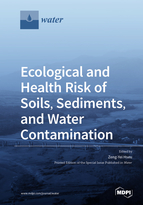Ecological and Health Risk of Soils, Sediments, and Water Contamination
A special issue of Water (ISSN 2073-4441). This special issue belongs to the section "Water and One Health".
Deadline for manuscript submissions: closed (15 August 2020) | Viewed by 27084
Special Issue Editor
Interests: soil contamination; biogeochemistry; pedology; nutrient cycles
Special Issues, Collections and Topics in MDPI journals
Special Issue Information
Dear Colleagues,
There has long been concern about the issue of soil, sediment, and water pollution by various contaminants worldwide. The contaminants pose potential threats to the environment and can damage human health through various exposed pathways, such as direct ingestion, dermal contact, diet through the food chain, inhalation, and oral intake. However, the contamination of soil and sediment related to water quality need a comprehensive approach to provide a reference for policy decisions in the remediation processes. Therefore, it is very important to understand the ecological and health risk for sustaining natural resources and ecosystems.
The Special Issue aims to gather high-quality papers emphasizing different aspects and findings of risk assessment for ecological and human health through soil, sediment, and water contamination.
Submitted contributions will go through a peer review process performed by independent reviewers. Original case studies and review papers are invited for publication in this Special Issue.
Prof. Dr. Zeng-Yei Hseu
Guest Editor
Manuscript Submission Information
Manuscripts should be submitted online at www.mdpi.com by registering and logging in to this website. Once you are registered, click here to go to the submission form. Manuscripts can be submitted until the deadline. All submissions that pass pre-check are peer-reviewed. Accepted papers will be published continuously in the journal (as soon as accepted) and will be listed together on the special issue website. Research articles, review articles as well as short communications are invited. For planned papers, a title and short abstract (about 100 words) can be sent to the Editorial Office for announcement on this website.
Submitted manuscripts should not have been published previously, nor be under consideration for publication elsewhere (except conference proceedings papers). All manuscripts are thoroughly refereed through a single-blind peer-review process. A guide for authors and other relevant information for submission of manuscripts is available on the Instructions for Authors page. Water is an international peer-reviewed open access semimonthly journal published by MDPI.
Please visit the Instructions for Authors page before submitting a manuscript. The Article Processing Charge (APC) for publication in this open access journal is 2600 CHF (Swiss Francs). Submitted papers should be well formatted and use good English. Authors may use MDPI's English editing service prior to publication or during author revisions.
Keywords
- Soil contamination
- Sediment contamination
- Water contamination
- Remediation
- Ecological risk
- Human health risk
- Risk assessment






